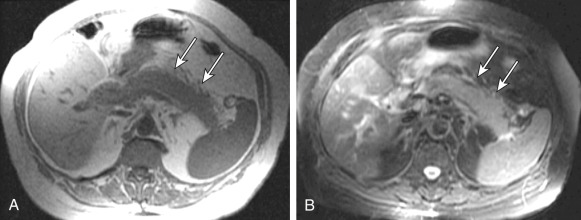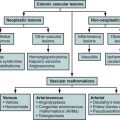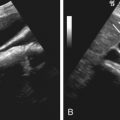Autoimmune Pancreatitis
Etiology
Autoimmune pancreatitis (AIP) is a peculiar form of chronic pancreatitis characterized by a fibroinflammatory process involving multiple organs with characteristic histopathologic and serologic features, association with other autoimmune disorders, and a propensity to respond to corticosteroid therapy (CST). Two subtypes of disease have recently been described: type I, also known as lymphoplasmacytic sclerosing pancreatitis, is considered a spectrum of immunoglobulin G4 (IgG4)-related systemic disease and represents the predominant form in the United States, Japan, and Korea and is characterized by seropositivity, whereas type II, also known as idiopathic duct-centric pancreatitis, is more commonly seen in Europe and is characterized by seronegativity. The occurrence of AIP in concordance with other autoimmune disease processes ( Box 50-1 ) as well as pathologic findings have led to acceptance of its immune-mediated causes, possibly in genetically susceptible patients. For example, 16% to 30% of patients with type II AIP carry or will subsequently be diagnosed with inflammatory bowel disease (IBD). Absence of prior attacks of acute pancreatitis or alcohol abuse is a notable feature of this form of pancreatitis. Although a benign disease, it often mimics pancreatic malignancy clinically and radiologically.
- •
Diabetes mellitus
- •
Idiopathic thrombocytopenic purpura
- •
Inflammatory bowel disease
- •
Rheumatoid arthritis
- •
Primary sclerosing cholangitis
- •
Primary biliary cirrhosis
- •
Sjögren’s syndrome
- •
Systemic lupus erythematosus
Prevalence and Epidemiology
Although there has been an increasing trend in diagnosis of AIP since it was first described in 1961, this trend is thought to be due to increasing awareness of the disease process and prevalence rate of AIP is still unclear. However, certain differences have been observed in the Western and Japanese populations. Type I predominantly arises in men over 50 years of age, typically in the sixth and seventh decades, whereas type II predominantly arises in a slightly younger population in the fifth decade without a gender predilection. However, disease can affect a wide age range, with documented cases even in pediatric populations.
Clinical Presentation
Clinical presentation of AIP is generally nonspecific. Symptoms related to pancreatic involvement include vague upper abdominal pain, jaundice, nausea, vomiting, weight loss, steatorrhea, back pain, and exocrine and endocrine dysfunction with type 2 diabetes mellitus arising at or before the onset of AIP. Patients may present with acute pancreatitis, type II more commonly than type I, although obstructing jaundice is a more common presentation. Often, up to 75% of older patients will present with obstructive jaundice, making differentiation of pancreatic malignancy difficult. However, most will present with nonspecific or mild symptoms that are overlooked, which results in delay in diagnosis, some to the stage at which changes of chronicity such as atrophy or strictures have set in.
Extrapancreatic manifestations involving the biliary tree, liver, kidney, retroperitoneum, bowel, lungs, lymph nodes, orbits, and salivary glands may occur in 60% of patients, with incidental detection of pancreatic involvement. Aside from known associations with IBD, extrapancreatic manifestations are considered rare in type II AIP and are commonly seen in type I AIP.
Depending on the subtype, the disease may relapse or persist in a milder form for a time before it is diagnosed. Type I AIP has a relapse rate of up to 59%, with most occurring within first 3 years, whereas type II AIP does not appear to relapse.
Pathophysiology
Although the pathophysiology is still largely unknown, it is thought there is an aberrant response to self-antigens that induces cellular and humoral response with resultant chronic inflammation maintained by the complement cascade and IgG4. Nearly half of the patients also demonstrate elevated IgE levels and eosinophils, which are typically seen in allergic reactions, and it is unclear if allergic cascade also may be involved in pathogenesis of AIP.
Pathology
Laboratory
Obstructive jaundice from pancreatic inflammation can result in elevated levels of bilirubin and other biliary enzymes. Serum amylase and lipase values can be marginally abnormal. The pancreatic tumor marker CA 19-9 can be elevated, and this is probably due to cholestasis. Inflammation of pancreatic acinar, beta, and alpha cells results in exocrine and endocrine dysfunction with reduction in volume and amylase content of pancreatic secretions with normal bicarbonate content as well as reduction in secretion of insulin and glucagon. CST can reverse inflammation affecting beta cells but not the reduction in number, resulting in residual dysfunction.
Serology
Elevated serum IgG4, is a characteristic feature in type I AIP. Elevated titers of various antibodies such as antinuclear antibodies, rheumatoid factor, anti–carbonic anhydrase antibody, perinuclear antineutrophil cytoplasmic antibody, anti–smooth muscle antibody, antimitochondrial or antilactoferrin antibody, and variable antibodies to trypsinogen and pancreatic secretory trypsin inhibitor have been variably reported, although none are consistently positive. It is unclear if these antibodies are primarily or secondarily produced as a result of inflammatory change. Serum IgG4 is more sensitive than total IgG for diagnosis of type I AIP. It is, however, not specific or diagnostic, because elevated levels have been observed in other forms of acute and chronic pancreatitis, in pancreatic carcinoma, and in individuals without any pancreatic disease (3% to 10%). Also, in the Western population, raised IgG4 levels have been inconsistently observed. A higher IgG4 cutoff value (280 mg/dL, twice the upper limit of normal) is considered highly sensitive and specific (>95%) in distinguishing AIP from pancreatic cancer. Although the positive predictive value of IgG4 is very low (~36%) owing to the low prevalence of disease compared with other conditions with raised IgG4, the negative predictive value is very high (99%). Whenever elevated, IgG4 level can be a useful marker to monitor disease activity in type I AIP, and as it is not consistently elevated, it cannot be used solely to diagnose relapse or assess treatment response. On the other hand, a high level of CA 19-9 (>100 units/mL) is more suggestive of pancreatic carcinoma. In patients with lower or absent levels of serum IgG4, as is typically the case in type II AIP, the combination of clinical picture, extrapancreatic involvement, and characteristic imaging features are useful. Diagnosis can be confirmed on core biopsies.
Gross Pathology
Resection of pancreas affected by AIP could be difficult owing to smoldering, peripancreatic inflammation, and fibrosis with distortion of surgical planes making dissection difficult and resulting in higher blood loss and longer operating time. On gross inspection, the pancreas is unremarkable but it is firm to rock hard on palpation. No dominant masses or well-circumscribed nodules are detected.
Histopathology
Depending on the preponderance of involvement, AIP has been subtyped into types I and II. Lobular and ductal involvement is often patchy, which hampers definitive diagnosis on needle biopsy. The differences encountered between the two groups are listed in Table 50-1 .
| Features | Type I: Lymphoplasmacytic Sclerosing Pancreatitis | Type II: Idiopathic Duct-Centric Pancreatitis |
|---|---|---|
| Gender | Male predominance | No gender predominance |
| Age | >50 (median seventh decade) | Generally younger than type I, fifth decade |
| Population predominance | Predominant form in Asia and North America | More common in Europe |
| Pathology | Predominant lobular and septal Lymphoplasmacytic infiltration Storiform fibrosis Obliterative endophlebitis common | Predominant ductcentric Ductal epithelial granulocytic infiltration Can lead to ductal narrowing Neutrophilic microabscesses and ulceration Obliterative endophlebitis uncommon |
| IgG4 | Elevated | Typically normal |
| Relapse | Frequent (up to 59%) | Extremely rare |
| Common extrapancreatic manifestation | Salivary glands, liver, kidneys, and retroperitoneum | Association with inflammatory bowel disease |
Type I AIP is characterized by dense lymphoplasmacytic infiltration in the pancreatic parenchymal lobules with secondary interlobular and intralobular fibrosis, often characterized by a swirling pattern of fibrosis known as storiform fibrosis. Obliterative endophlebitis is commonly seen. Plasma cells are IgG4 positive. Inflammatory infiltrate spills into the peripancreatic soft tissue, resulting in characteristic imaging appearance.
Type II AIP is characterized by ductal epithelial granulocytic infiltration with neutrophilic microabscesses and ulcerations with resultant ductal damage and obliteration. They typically do not stain for IgG4 or IgG4-positive plasma cells, and obliterative endophlebitis is uncommon. Inflammatory infiltrates invade and compress the walls of the pancreatic duct and common bile duct (CBD), resulting in thickening and luminal narrowing. If not treated, chronic inflammation results in fibrosis and stricture.
Extrapancreatic lesions, like in type I AIP, reveal lymphoplasmacytic infiltration, fibrosis, IgG4-positive plasma cells, and obliterative endophlebitis and can aid in differentiation of AIP associated sclerosing cholangitis from primary sclerosing cholangitis. Renal lesions reveal tubulointerstitial nephritis with lymphoplasmacytic infiltration and fibrosis.
Immunoglobulin G4 Immunohistochemistry
Organs affected by type I AIP have a lymphoplasmacytic infiltrate rich in IgG4-positive plasma cells on immunostaining, even in absence of serum IgG4 elevation. Although higher numbers of pancreatic IgG4-positive plasma cells have been identified in AIP compared with pancreatic carcinoma and chronic pancreatitis, this overlap precludes the use of immunostaining as an absolute diagnostic means, particularly when evaluating a biopsy specimen. However, a ratio of IgG4 to IgG of greater than 40% in an involved organ has been suggested by some to be more likely to represent AIP. Although it was once thought that the presence of large numbers of IgG4-positive plasma cells supported the diagnosis, type II AIP often will not demonstrate lymphoplasmacytic infiltrates nor elevation in IgG4.
Immunogeneity
Type I AIP demonstrates increased frequency of certain human leukocyte antigen haplotypes, for example, involving the DRB1*0405 and DQB1*0401, and DRB1*0410, substitution of aspartic acid to nonaspartic acid at DQbeta157, and polymorphisms of cytotoxic T lymphocyte–associated protein 4 and Fc receptor–like gene 3. Some of these changes have been associated with high relapse rates and may serve as a prognostic indicator in the future.
Imaging
Multiple diagnostic criteria such as the Japan Pancreas Society (Revised proposal, 2006), HISORt (histology, imaging, serology, other organ involvement, and response to therapy) criteria from the Mayo Clinic, Korean criteria, and International Consensus Diagnostic Criteria are currently in use, incorporating imaging, laboratory, serologic features, histopathologic findings with extrapancreatic manifestations, associated disorders, and response to corticosteroids.
Computed Tomography
Computed tomography (CT) is considered the modality of choice for assessing pancreatic and extrapancreatic manifestations of AIP. Focal, multifocal, or, more frequently, diffuse swelling of the pancreas is the most common imaging feature in both types of AIP. Although CT cannot be used to differentiate between two forms, type I tends to demonstrate diffuse swelling whereas type II has the propensity to be more focal. The classic appearance is a diffusely enlarged, sausage-shaped pancreas with sharp borders and a featureless appearance (absent normal pancreatic clefts) with homogeneous attenuation. Although the enhancement pattern varies depending on inflammation and fibrosis, moderate heterogeneous and delayed enhancement is often seen with fibrosis. A peripheral, smooth, well-defined rim of hypoattenuating halo around the pancreatic parenchyma represents fluid, phlegmon/inflammatory exudate, and fibrous tissue ( Figure 50-1 ) with minimal peripancreatic fat stranding. Infrequently, the halo reveals a capsule-like enhancement on delayed phase of contrast enhancement. In type II AIP, ductal injury may lead to pancreatic atrophy with retraction of the pancreatic tail (“tail cutoff”) in up to 40% of cases ( Figure 50-1 and Figure 50-2 ). Multifocal enlargement of the pancreas occurring concurrently or spaced in time has been noted ( Figure 50-2 ).
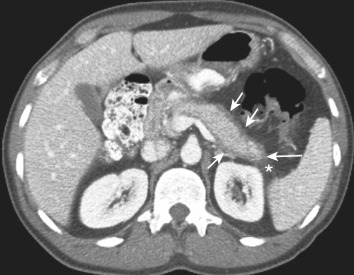
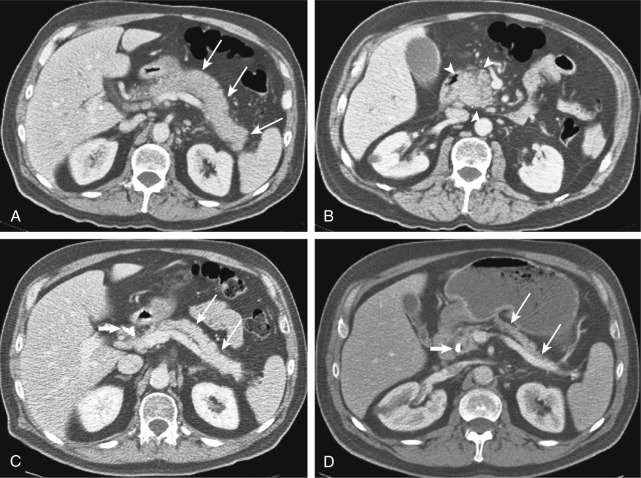
With advanced disease, there may be development of focal mass-like swelling (see Figures 50-2 and 50-3 ), more commonly in type II AIP. This has been reported more commonly in Western populations and is known as pseudotumorous pancreatitis or inflammatory pancreatic mass; in Japan it is known as tumor-forming pancreatitis. Mass-like swellings are often misdiagnosed as chronic alcoholic pancreatitis (which can be distinguished from AIP by presence of necrosis, abscesses, stones, and reparative granulation tissue), and pancreatic carcinomas and may be surgically resected. Homogeneous delayed enhancement may be seen on CT. Distinguishing features of pancreatic carcinoma and AIP are summarized in Table 50-2 .

| Differentiation Factors | AIP | Pancreatic Cancer |
|---|---|---|
| Serology | Elevated IgG 4 | Elevated CA 19-9 |
| Imaging characteristics | Peripancreatic halo, delayed enhancement, extrapancreatic disease | Low density mass, regional/metastatic spread, upstream pancreatic atrophy |
| Ductal characteristics | Long segment or multiple pancreatic ductal strictures, absence of upstream dilatation | Short segment pancreatic ductal stricture with upstream dilatation, duct cutoff |
| Histopathology | Storiform fibrosis, lymphoplasmacytic infiltrates, obliterative endophlebitis, ductal epithelial granulocytic infiltration | Malignant cells |
| Treatment | Steroid responsive | Surgical resection/chemotherapy |
Segmental or diffuse irregularity and narrowing of the pancreatic duct secondary to compression from surrounding inflammation, with or without thickening and enhancement, is seen. The distal CBD may reveal tapered narrowing owing to compression from adjacent pancreatic parenchyma or from involvement of CBD by the disease process; the involved duct also may reveal contrast enhancement. Involvement of the CBD and resulting biliary obstruction often require biliary drainage (see Figures 50-2 and 50-3 ).
Pancreatic swelling, peripancreatic changes, and irregular narrowing of the pancreatic duct usually improve in most, especially if CST is instituted early in the course of disease. Biliary narrowing also improves with CST, allowing withdrawal of biliary drainage tubes. Ductal stricture develops in the absence of timely institution of CST or with a protracted disease course, which may result in irregular upstream dilatation of the pancreatic duct.
Vascular encasement is conspicuously absent, although mass effect on the vessels and narrowing of peripancreatic veins can be seen. Vascular complications such as compression and thrombosis have been reported in 23% of patients.
Occasional pancreatic cysts have been reported; these are known to disappear with or without treatment, without any sequelae. AIP is rarely associated with stone formation, and more so in relapsing cases. Pancreatic calcification and ascites are not seen. A long-term, protracted disease course often results in atrophy of the gland (see Figure 50-2 ).
Extrapancreatic manifestations can occur simultaneously or before or after detection of pancreatic involvement and are listed in Box 50-2 . Extrapancreatic manifestations may be useful in supporting diagnosis in equivocal cases.
- •
Abdominal, cervical, or hilar lymphadenopathy
- •
Gastric, duodenal, or colonic infiltration
- •
Interstitial pneumonia
- •
Orbital pseudotumor
- •
Renal lesions (35%)
- •
Retroperitoneal fibrosis (3% to 8%)
- •
Sclerosing cholangitis (68% to 88%)
- •
Sialadenitis (12% to 16%)
Renal lesions are typically parenchymal, predominantly involving the cortex, and are numerous and nonenhancing. However, perirenal tissue, renal sinus, and renal pelvis may be involved. They are detected on contrast-enhanced studies as wedge-shaped, ill-defined, rounded or nodular or diffuse and patchy lesions ( Figure 50-4, A ). Differentials may include pyelonephritis, vascular insult, lymphoma, renal cell carcinoma, or Wegener’s granulomatosis. Soft tissue masses in the renal pelvis associated with AIP can resemble urothelial tumors and lymphomas. A perirenal rim of soft tissue and thickening of the renal pelvic wall also can be seen. Renal lesions do not affect renal function in the early stage; however, long-term effects, with or without CST, are not yet clearly known. Eventually, fibrosis in the late stage results in cortical volume loss.
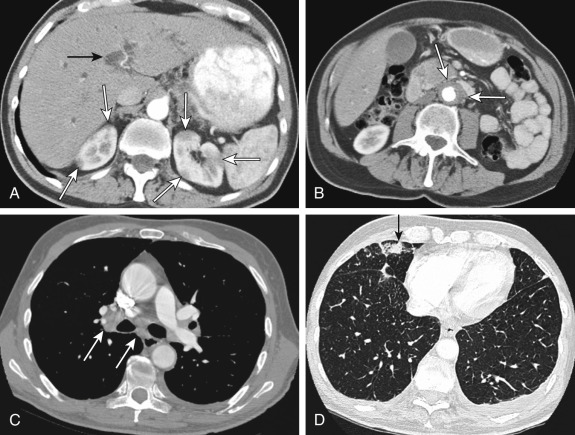
Retroperitoneal fibrosis most commonly appears as a mantle of tissue adjacent to the aorta and other retroperitoneal structures and is morphologically indistinguishable from other causes of retroperitoneal fibrosis (see Figure 50-4, B ). If untreated, it can also result in hydronephrosis.
Association of ulcerative colitis with AIP is more frequently observed in the Western population and in a relatively younger age group, commonly in type II AIP. Typical findings of acute, subacute, and chronic inflammatory changes of large bowel are seen on CT.
The incidence of AIP-associated sialadenitis is higher in the Japanese population. Sialadenitis co-occurring with AIP is negative for anti-SSA and anti-SSB antibodies, shows elevated serum IgG4 levels and IgG4-positive plasma cell infiltration in tissue, and is thus different from Sjögren’s syndrome. Involved salivary glands (parotid or submandibular) are enlarged, which can be confirmed by scintigraphy.
Abdominal, cervical, and hilar adenopathy have been reported in association with AIP and tends to respond to CST (see Figure 50-4, C ). Like the halo sign seen in the pancreas, enlarged lymph nodes can demonstrate perinodal halo.
Pulmonary involvement may result in discrete or diffuse nodules or infiltrates (see Figure 50-4, D ).
Magnetic Resonance Imaging and Magnetic Resonance Cholangiopancreatography
There is no specific indication for MRI in evaluation of AIP, although MRI is more sensitive and can detect recurrent disease in up to 22% of patients who are clinically and biochemically asymptomatic. MR cholangiopancreatography (MRCP) can be performed as a noninvasive technique in lieu of endoscopic cholangiopancreatography (ERCP) for evaluation and subsequent follow-up of ductal changes.
Involved pancreas appears hypointense on T1-weighted images and hyperintense on T2-weighted images when inflammation is predominant and hypointense when fibrosis predominates ( Figure 50-5 ). Delayed parenchymal enhancement is seen after intravenous administration of gadolinium. The “halo” appears hypointense on T1- and T2-weighted images. Delayed capsule–like enhancement of halo is better appreciated on T1-weighted fat-suppressed gadolinium-enhanced MR images compared with CT. The pancreatic portion of the CBD can demonstrate delayed wall enhancement. Sometimes, the obliteration of pancreatic duct by the focal or diffuse AIP may be difficult to differentiate from pancreatic cancer. More recent work has demonstrated use of ADC values to differentiate AIP from chronic pancreatitis and cancer, most demonstrating lower ADC values in AIP compared to chronic alcoholic pancreatitis or pancreatic cancer. Renal parenchymal and sinus lesions appear hypointense on T1- and T2-weighted imaging.

